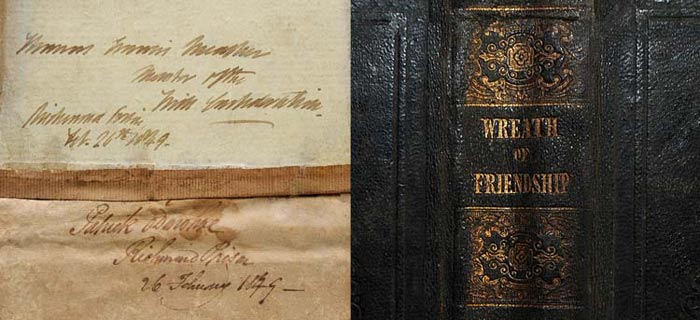There is an old Irish expression “Ní bhíonn cuimhne ar an arán a hitear”, commonly translated as ‘Eaten bread is soon forgotten”.
Today was such a case, it being the 200th anniversary of the birth of General Thomas Francis Meagher [born 3rd August 1823 – died 1st July 1867], himself the man who gave us our Irish Tricolour.
Yet today passed sadly forgotten, by not just Co. Tipperary, but also sadly by the Irish nation. Read HERE and watch the video contained.

Both signatures are written on the back of a prison library book called “Wreath of Friendship”.
Picture: G. Willoughby.
Thomas Francis Meagher was an Irish nationalist and leader of the “Young Irelanders” who led the Ballingarry (SR) Rebellion of 1848, [Battle of the Widow McCormack’s Cabbage Patch], before being convicted of sedition and sentenced to death, but instead received transportation, for life, to Van Diemen’s Land (now Tasmania) off the Southern coast of Australia.
In 1852, Meagher escaped on a whaling ship and made his way to the United States, where he settled in New York City. He studied law, worked as a journalist, and travelled widely to present lectures on the Irish cause.
At the beginning of the American Civil War, Meagher joined the U.S. Army and rose to the rank of Brigadier General and was most notable for recruiting and leading the Irish Brigade, encouraging support among Irish immigrants for the Union Army side. Here in Ireland he had one surviving son whom he never met.
Following the American Civil War, Thomas F.Meagher was appointed Montana’s Territorial Secretary of State by President Andrew Johnson, and served as acting territorial governor. In 1867, Meagher drowned in the Missouri River after falling from a steamboat at Fort Benton, Montana. His death has been disputed by historians, with varying hypotheses including weakness from dysentery, intoxication, suicide and murder.
Patrick O’Donoghue whose signature is shown avove, in his diary record, refers here to the Irish flag, Quote: “We entered Mullinahone for the first time, and unfurled the green banner.”
Irish tricolours were mentioned in 1830 and 1844, but widespread recognition is not accorded the flag until 1848. From March of that year Irish tricolours appeared side by side with French flags, at meetings held all over the country to celebrate the revolution that had just taken place in France.
In April, Thomas Francis Meagher, this Young Ireland leader, brought a tricolour of orange, white and green from Paris and presented it to a Dublin meeting.
John Mitchel (1815-1875) referring to it, said: “I hope to see that flag one day waving, as our national banner”.
Although the tricolour was not forgotten as a symbol of hoped-for union and a banner associated with the Young Irelanders’ and revolution, it was little used between 1848 and 1916. Even up to the eve of the Rising in 1916, the green flag held an undisputed right to flutter in the then ever changing winds that was truly the now politically forgotten, County of Tipperary which was deciding the paths which were to guide Irish history.
Remember the statement by Thomas Davis, also earlier editor of ‘The Nation Newspaper’ in the 1840’s, “Where Tipperary Leads, Ireland Follows.”
But maybe, and sadly, not any more.

Leave a Reply